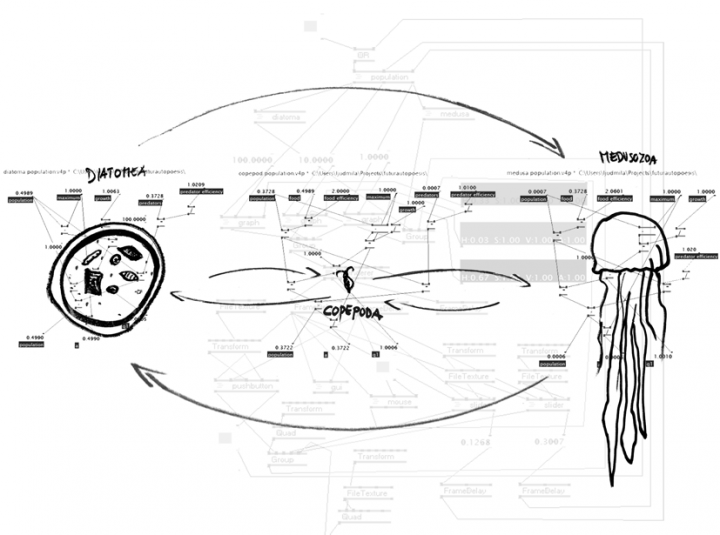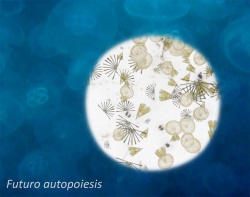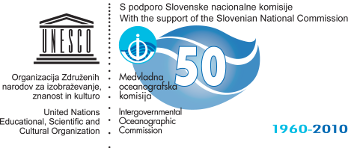Robertina Šebjanič: Futuro Autopoiesis

Coding and realization: Žiga Kranjec and Luka Frelih
Field consultants and advisors: Špela Petrič and Urban Belina
Special thanx to: dr. Alenka Malej (MBPP - Marine biology station Piran) for consulting, dr. Aleš Kladnik (Biotechnical faculty, University of Ljubljana) for micrography - video and photographies, dr.Valentina Turk (MBPP) - for micrography - photographies, Tihomir Makovec (MBPP) - for subaquatic videos of moon jellyfishes, Jani Forte (MBPP) for consulting and Saša Spačal.
Futuro autopoiesis: Likovni salon Celje, 28.10. – 5.12.2010
Futuro Autopoiesis touches various ecologic issues and focuses on the research of the structural contact between an organism as a closed system and its environment. It establishes a futurotopic auto-poetic environment, through which we can step into an interactive simulation of the possible future ecologic development and critically reflect upon our influence on the stability/instability of the ecosystem.
On 10 November, at 7 p.m. the curator Irena Čerčnik will host a debate with Robertina Šebjanič, Luka Frelih and Špela Petrič, her expert co-worker.
Robertina Šebjanič, who expresses her artistic self predominantly through video and new media practices has always been known for her experimental approach. She likes to explore the technical characteristics of the medium and she skillfully takes advantage of the possibilities offered by the new technologies. Lately this has been joined by her dedication to the current social and environmental issues, especially the one that deals with the issues of co-existence and co-dependency. Her involvement is never a questionable delivery of a seemingly objective truth that would be based merely on a non-critical recapitulation of results from various sources. She tries to stimulate the viewer’s realisation of his responsibility, but not by causing uneasiness or giving instructions but through a playful manner that uses the work of art to create an interactive environment that leads the viewer through cooperation, intervention and observation of the consequences and makes him to think about the issues that represent the central theme in her work. This certainly holds true for her most recent work Futuro Autopoiesis, which touches ecological issues and will be exhibited for the first time in Likovni salon Celje. The setting, for which it could be said that it in some segments obtains the characteristics of a computer game, will lead the visitor into an active presentation of the fragile ecosystem. With the use of the interactive interface the viewer will be able to change the environmental factors and thus influence the events. The viewer will not be merely an observer from the sidelines, but one of the main sources of the environmental disorders. The establishment of a situation that leads the viewer to critically reflect upon his influence on the stability or instability of the ecosystem is the main intention behind the Futuro Autopoiesis project, which is based on the artist’s research and her cooperation with the experts in the field of biology and technology.
Robertina Šebjanič has a few independent presentations under her belt (Galerija Alkatraz, Studio SCCA Ljubljana, Kiberpipa Ljubljana, Kibela Maribor) as well as numerous co-operations at group exhibitions and festivals at home and abroad. Networking is an important characteristic of her work as an artist, for it reaches from creating projects with other artists to cooperating with experts from other disciplines. Such are for instance the project Connected by signals (2009), which deals with communication and the transfer of information and its interpretation, that emerged in cooperation with the Swedish artist Mari Lagerquist, or the video installation Break of Whiteness (2010) that was created together with Mirjana Batinić. The interactive installation Pufination (2008) that exposes the relation to the coexisting as an important part of one’s survival and represents a group of objects/robots that communicate amongst themselves using a wireless network and with people through touch, sound, light and vibrations, emerged in cooperation with the connoisseur of new technologies and software developer Luka Frelih. The work exhibited on this occasion is also a product of the cooperation with Frelih. This work - that emerged in cooperation with experts from the field of biology - deals with ecological issues that are gaining in ideological dimensions and are often a victim of political and market manipulations and threats. The starting point of the interactive work which is based on the schematic presentation of the food chain that leads from the primary diatomea to their predators harpacticid copepod and their predators - jellyfish, is represented by the findings in the observations that were in the past years performed by the researches at the Marine Biology Station Piran.
Text by curator: Irena Čerčnik
Futuro autopoiesis at 4.6.2010 in Marine biology station Piran
Project Futuro Autopoiesis explores the structural coupling between organism as a closed-circuit system and it's environment. During the first phase of the project we constructed a simulation of a real environment - an interactive display of correlations between environmental variables and population dynamics of three groups of organisms (phytoplankton diatoms, copepod crabs and moon jellyfishes). The correlation of different variables opens a possibility for various narratives that base on the research done by Marine biology station Piran in the previous years. Interactive installation bases on in-built loops of co-dependance that introduce the visitor to the ecosystem of the Bay of Trieste and the influence of environmental variables influence on population count and biodiversity. Interactive logic bases on schematic representation of food chain leading from primary producers diatoms to their predators copepod crabs and to the copepod predators moon jellyfishes. The fascination of the simulated microscopic view and possibility of interactive playing with correlated relationships between micro-world of diatoms and macro-world of jellyfishes playfully lead the visitor into active imagination of ecosystem's fragility. Interactive interface of the installation enables manipulation of environmental conditions (surface water temperature and insolation) that in turn affects the generation of visual elements – diatoms and jellyfishes. The visitor thus enters the installation as an co-creator, he / she is one of the primary sources of environmental perturbation, defining the evolving narrative by manipulating the environmental variables.
This installation is a work in progress presentation after first stage of artistic research. Artistic team plans for the next phase encompass exploration of possible narratives of evolutionary change of microorganisms in extreme environments. We plan to construct a sublime strategy of representation of futurotopic environment that will enable the visitor to actively enter into ecological projection and critically reflect his own influence on ecosystems and their balances.
Produced by: LJUDMILA, Ljubljana New Media Lab at KUD F. Prešeren Project has been developed in collaboration with Marine biology station Piran and was funded by UNESCO Intergovernmental Oceanographic Commission Slovene National Commission, Ministry of Culture of Republic of Slovenia and City Council of Ljubljana


